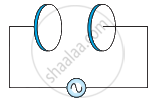Advertisements
Advertisements
Question
A parallel plate capacitor (Figure) made of circular plates each of radius R = 6.0 cm has a capacitance C = 100 pF. The capacitor is connected to a 230 V ac supply with a (angular) frequency of 300 rad s−1.
- What is the rms value of the conduction current?
- Is the conduction current equal to the displacement current?
- Determine the amplitude of B at a point 3.0 cm from the axis between the plates.

Solution
Radius of each circular plate, R = 6.0 cm = 0.06 m
Capacitance of a parallel plate capacitor, C = 100 pF = 100 × 10−12 F
Supply voltage, V = 230 V
Angular frequency, ω = 300 rad s−1
(a) The rms value of conduction current, I = `"V"/"X"_"C"`
Where,
XC = Capacitive reactance
= `1/(ω"C")`
∴ I = V × ωC
= 230 × 300 × 100 × 10−12
= 6.9 × 10−6 A
= 6.9 μA
Hence, the rms value of the conduction current is 6.9 μA.
(b) Yes, conduction current is equal to displacement current.
(c) Magnetic field is given as:
B = `(μ_0"r")/(2pi"R"^2)"I"_0`
Where,
μ0 = Free space permeability = 4π × 10−7 N A−2
I0 = Maximum value of current = `sqrt2"I"`
r = Distance between the plates from the axis = 3.0 cm = 0.03 m
∴ B = `(4pi xx 10^-7 xx 0.03 xx sqrt2 xx 6.9 xx 10^-6)/(2pi xx (0.06)^2)`
= 1.63 × 10−11 T
Hence, the magnetic field at that point is 1.63 × 10−11 T.
APPEARS IN
RELATED QUESTIONS
The charging current for a capacitor is 0.25 A. What is the displacement current across its plates?
When an ideal capacitor is charged by a dc battery, no current flows. However, when an ac source is used, the current flows continuously. How does one explain this, based on the concept of displacement current?
Displacement current is given by ______.
If the total energy of a particle executing SHM is E, then the potential energy V and the kinetic energy K of the particle in terms of E when its displacement is half of its amplitude will be ______.
A spring balance has a scale that reads 0 to 50 kg. The length of the scale is 20 cm. A body suspended from this spring, when displaced and released, oscillates with a period of 0.60 s. What is the weight of the body?
The displacement of a particle from its mean position is given by x = 4 sin (10πt + 1.5π) cos (10πt + 1.5π). The motion of the particle is
Displacement current goes through the gap between the plantes of a capacitors. When the charge of the capacitor:-
A parallel plate capacitor of plate separation 2 mm is connected in an electric circuit having source voltage 400 V. What is the value of the displacement current for 10-6 second if the plate area is 60 cm2?
According to Maxwell's hypothesis, a changing electric field gives rise to ______.
A capacitor of capacitance ‘C’, is connected across an ac source of voltage V, given by V = V0 sinωt The displacement current between the plates of the capacitor would then be given by ______
The charge on a parallel plate capacitor varies as q = q0 cos 2πνt. The plates are very large and close together (area = A, separation = d). Neglecting the edge effects, find the displacement current through the capacitor?
A variable frequency a.c source is connected to a capacitor. How will the displacement current change with decrease in frequency?
Show that the magnetic field B at a point in between the plates of a parallel-plate capacitor during charging is `(ε_0mu_r)/2 (dE)/(dt)` (symbols having usual meaning).
You are given a 2 µF parallel plate capacitor. How would you establish an instantaneous displacement current of 1 mA in the space between its plates?
Sea water at frequency ν = 4 × 108 Hz has permittivity ε ≈ 80 εo, permeability µ ≈ µo and resistivity ρ = 0.25 Ω–m. Imagine a parallel plate capacitor immersed in seawater and driven by an alternating voltage source V(t) = Vo sin (2πνt). What fraction of the conduction current density is the displacement current density?
AC voltage V(t) = 20 sinωt of frequency 50 Hz is applied to a parallel plate capacitor. The separation between the plates is 2 mm and the area is 1 m2. The amplitude of the oscillating displacement current for the applied AC voltage is ______.
[take ε0 = 8.85 × 10-12 F/m]
A particle is moving with speed v = b`sqrtx` along positive x-axis. Calculate the speed of the particle at time t = τ (assume that the particle is at origin at t = 0).
